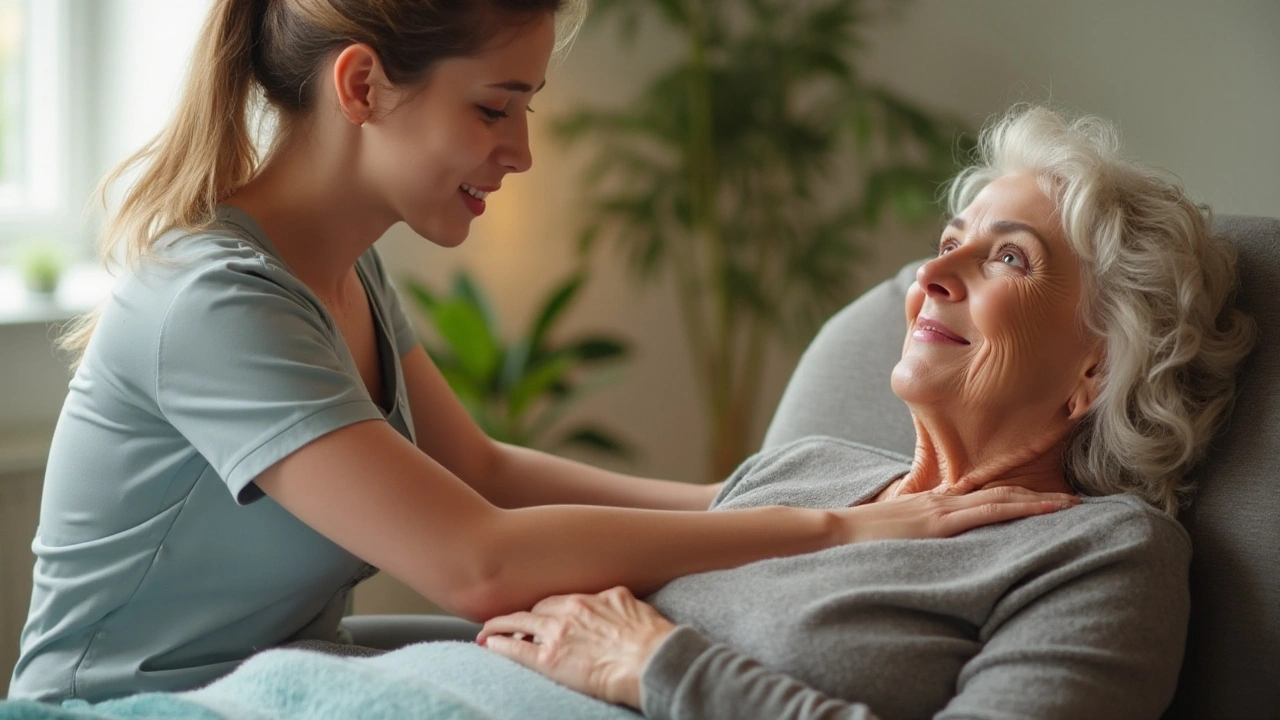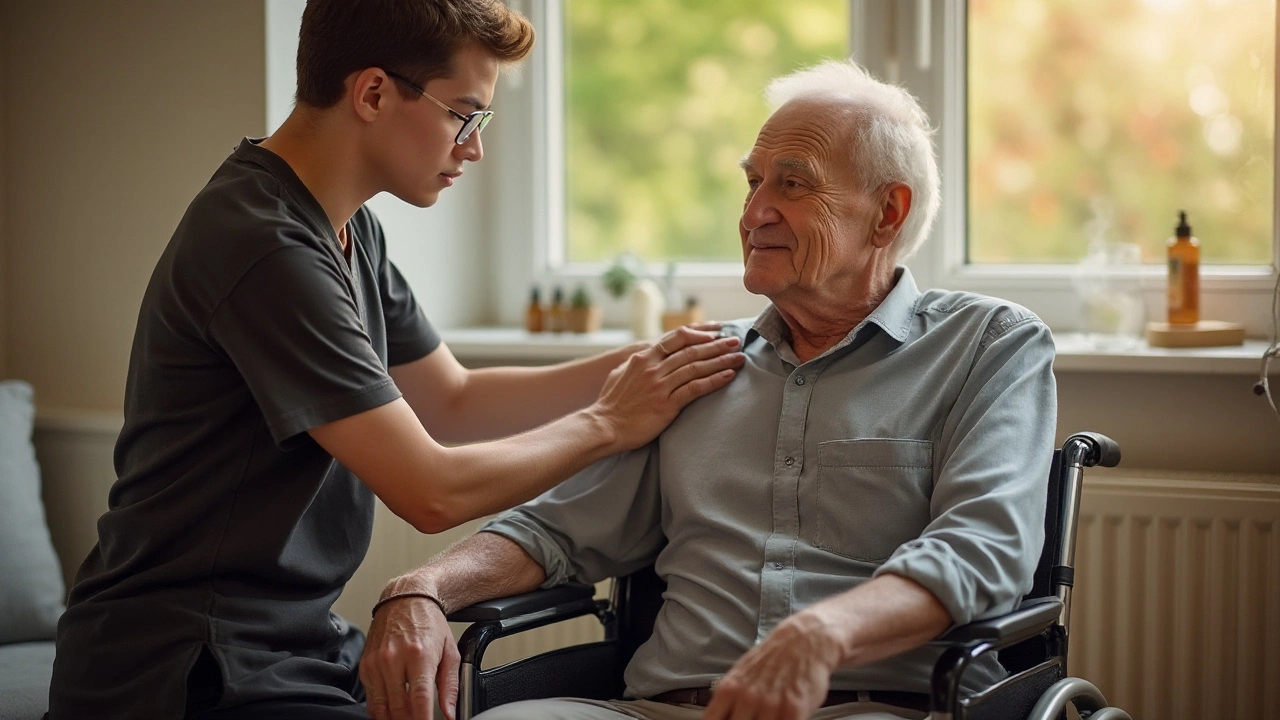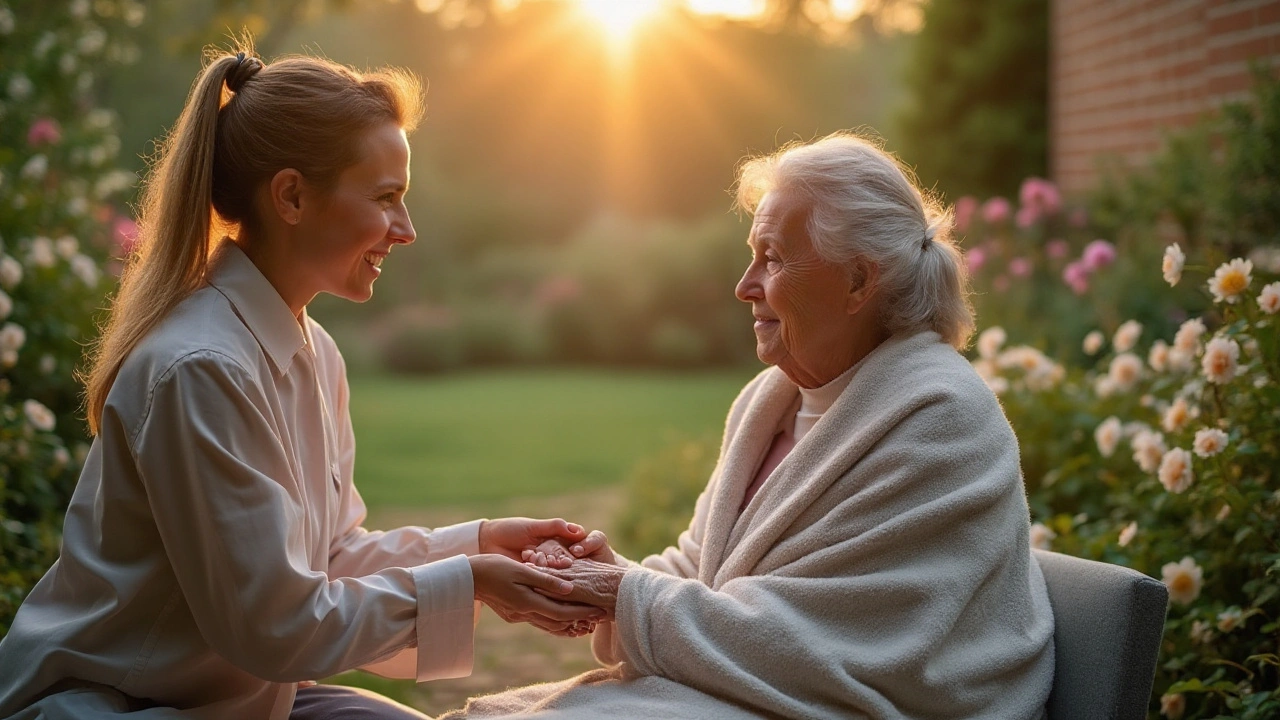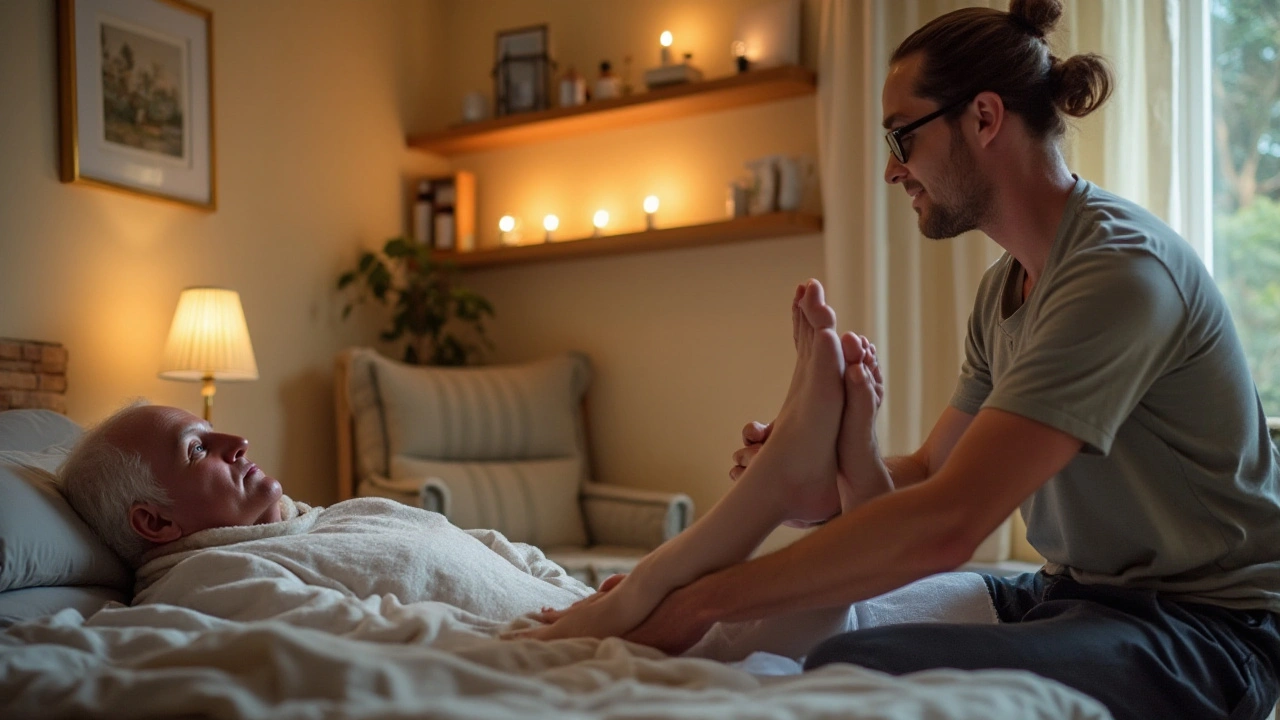Palliative Massage: A Comforting Solution for Pain Relief
 Jan, 19 2025
Jan, 19 2025
In a world filled with diverse therapeutic options, palliative massage stands out as a soothing haven for those encountering chronic pain. This therapeutic approach is much more than simple touch; it's a meaningful interaction designed to bring comfort to patients facing difficult journeys.
Palliative massage has been around for ages, offering a gentle yet effective way to manage pain and reduce anxiety. Unlike traditional forms, it places a significant emphasis on understanding individual needs and forming connections. Whether it’s the calming embrace of a soft touch or the relief brought by specific techniques, palliative massage seeks to provide a balance of physical ease and emotional support.
- Understanding Palliative Massage
- Techniques and Benefits
- Therapist and Patient Relationships
- Practical Tips for Implementing Palliative Massage
Understanding Palliative Massage
Palliative massage emerges as a profound branch of therapy, meticulously crafted to alleviate discomfort and provide solace for those contending with serious or terminal illnesses. Unlike conventional massage, which typically targets muscle tension and aches among relatively healthy individuals, palliative massage takes on a more holistic role. This method recognizes the unique physical and emotional challenges encountered by patients in palliative care, offering tender support through skillful touch. By weaving together compassion and expertise, this practice focuses on enhancing well-being and quality of life for individuals, addressing aspects that traditional medical treatments might overlook.
Essentially, palliative massage is underpinned by the understanding that touch has a remarkable ability to communicate care and comfort. In an environment where patients may often experience high levels of stress, anxiety, and isolation, the presence of a trained massage therapist can provide not just relief but a sense of connection that transcends the physical. It's important to acknowledge that every patient is unique; therefore, the massage techniques employed are often tailored to suit individual needs and preferences. Some may desire light, gentle strokes for a more calming effect, while others might benefit from slightly firmer pressure to ease diminished mobility and stiffness.
Scientific studies have shown that palliative massage can significantly reduce the perception of pain, making it a crucial supplement to medical treatment. This fact is reinforced by a report from the American Massage Therapy Association: "Massage has consistently been shown to reduce pain and enhance relaxation, significantly contributing to the patient's sense of well-being." Palliative care environments often prioritize comfort and dignity, making the use of massage an integral part in comprehensive care plans. This encompasses both the physical symptom relief and the emotional support that fosters an atmosphere of compassion.
Moreover, therapists who specialize in palliative massage often work closely with medical staff to ensure that their approaches are complementary to ongoing medical treatments. There's a collaborative spirit here that ensures patient care is seamless and integrative. The gentle nature of palliative massage harmonizes beautifully with other modalities such as aromatherapy, music therapy, and more, crafting a sensual symphony that tackles suffering on multiple fronts. For caregivers and family members, understanding this technique can be empowering. They can not only appreciate the nuanced care provided to their loved ones but also learn basic comforting massages to offer personal, tender interaction.

Techniques and Benefits
Palliative massage is defined by its vast array of gentle techniques aimed primarily at comfort and alleviation of pain. One of the most common methods employed is effleurage, which involves long, soothing strokes that help to relax the muscles and calm the mind. These motions not only serve to ease physical tension, but also work to lower anxiety levels, providing a holistic release for patients undergoing stress. Another technique used is petrissage, a form of kneading that, when applied with care, can stimulate circulation and support the body’s natural healing processes. Such methods are instrumental in palliative care, as they merge physical touch with compassion, crafting unique sessions customized to the specific needs and sensitivities of patients.
Massage therapy within a palliative setting often goes beyond mechanical movements. There's a profound connection fostered between therapist and patient, something akin to a subtle dance where intuition guides the session. Therapists are often trained to interpret non-verbal cues, adjusting their touch accordingly to best meet the comfort needs of the individual. Notably, patients have reported a marked improvement in their emotional well-being, describing sessions as a sanctuary of peace amidst the challenges they face. As a testament to this benefit, a study published in the Journal of Pain and Symptom Management revealed that patients receiving regular palliative massages experienced a significant decrease in reported pain levels and an astonishing increase in quality of life.
The benefits of palliative massage extend beyond managing pain relief. Immune function improvement is another noteworthy advantage. By reducing stress hormones in the body through gentle touch, the immune system can operate more efficiently. In this context, the application of essential oils, such as lavender or chamomile, during massage sessions can enhance relaxation and aid in empowering the body’s defenses. Moreover, the act of using these oils ties the senses together, creating an environment that promotes tranquility and deep relaxation, essential elements in the recovery and comfort of patients in palliative care.
"Touch has a memory," said John Keats, and it resonates deeply in the realm of palliative massage where memories of comfort and care can be a powerful antidote to fear and despair.
With benefits touching both the physical and the emotional realms, it's not surprising that those administering palliative massage often play a vital role in the healthcare team. They not only address the evident physical discomforts but also uplift the spirit, offering an unspoken message of care and understanding. However, it is always crucial for therapists to be mindful of choosing techniques that align with a patient’s medical condition, ensuring that the experience is both safe and beneficial. The gentle art of massage therapy in palliative care is indeed a testament to how compassion, skill, and understanding can tip the scales toward healing and hope.

Therapist and Patient Relationships
The bond between a therapist and a patient in palliative care is more than just a professional connection; it is a partnership built on trust, empathy, and understanding. When pain is a constant companion, as it often is for those seeking massage therapy in palliative settings, the role of the therapist transcends technique. This relationship provides a sanctuary, a brief escape from discomfort, allowing a patient to feel truly heard and cared for.
Communication is a cornerstone of this relationship. Open dialogue ensures that each session is tailored to the specific needs and preferences of the patient. Experienced therapists will attentively listen, asking about pain levels, emotional states, and any particular areas requiring focus. Such communication is key to creating a comfortable environment where patients feel safe in expressing their needs and concerns. This not only enhances the practical aspects of the therapy but also reinforces its emotional benefits.
The emotional intelligence of a therapist is crucial. Empathy and patience enable therapists to respond to the fluctuating needs of their clients. Understanding the emotional undercurrents of pain and the stressors that accompany chronic illness allows therapists to offer comfort beyond the physical realm.
"The healer's reach is often in how they listen," reminds Dr. Melanie Green, a renowned expert in the field.This philosophy is embedded deeply in palliative massage, where the touch is informed by genuine concern and the patient’s response guides each movement.
Trust-building is another significant aspect. For patients facing severe illness, vulnerability is pronounced. Therapists should demonstrate consistent care and professionalism in every interaction. Respecting personal boundaries and offering privacy when required helps in fostering a sense of security. This trust transforms the therapy into a holistic experience, addressing not just physical ailments but psychological burdens as well.
Family members, too, can play a role in enhancing these interactions. Therapists often collaborate with family members to gather insights into the patient’s day-to-day challenges and preferences. This collaborative approach ensures continuity of care and a more personalized treatment plan. Engaging with family not only informs the session but also empowers them to be part of the healing process.
Establishing such deep connections can be rewarding for therapists as well, as it enriches their practice and offers a sense of purpose. The ongoing learning and adaptation required in palliative massage keep therapists engaged and motivated, knowing they are making a tangible difference in someone’s life. This evolving dynamic, cultivated by compassion and skill, ultimately allows for a profound therapeutic journey that nurtures both patient and healer alike.

Practical Tips for Implementing Palliative Massage
Implementing palliative massage can be a sensitive yet gratifying task, especially when it comes to enhancing the well-being of individuals experiencing significant physical discomfort. The key is to approach each session with empathy and adaptability, understanding that each person’s needs and thresholds may vary significantly. It's crucial to begin with obtaining a clear understanding of the patient's overall health condition and specific areas where pain and tension manifest. Communication is essential; ask the patient or their caregivers about any particular preferences or contraindications before starting a session. Listening actively to their concerns not only helps in creating a tailored massage plan but also fosters trust and comfort, a vital component of effective palliative care.
The choice of massage technique should align with the primary aim – comfort. Focus on gentle strokes such as effleurage, which involves smooth, gliding movements to help calm the nervous system and encourage relaxation. Pay special attention to areas like the back, shoulders, and feet, which often store stress and tension. It might also be beneficial to incorporate other elements like soothing music or aromatherapy, as long as they don't overwhelm or distract the patient.
Instruments like heat pads can be employed, provided they are used at a low setting and for short durations to prevent any adverse reactions. A holistic approach that combines various methods, chosen according to the patient's comfort levels, typically yields the best results. Remember, the goal isn't therapeutic pressure, but rather a comforting touch that can help alleviate pain and create a sanctuary of peace.
Remember, a good massage therapist not only uses their hands but their ears too. Being open to feedback regarding pressure levels or any discomfort signals greatly improves the experience. Establish a feedback loop where the patient feels safe to express what feels right or wrong. As noted by the American Massage Therapy Association, "Undergoing regular massage sessions can lead to a significant improvement in mood and overall sense of well-being."
Adjustability and patience are key virtues, allowing the therapist to explore new techniques or coordinate care with other healthcare providers for optimal outcomes.
Practical knowledge is immensely helpful in this context. Consider participating in workshops or courses that specialize in massage therapy for palliative care. Engaging with professionals and learning from real-world scenarios can be an invaluable experience. Additionally, some therapists may find it helpful to keep a journal of sessions, noting different techniques and responses to tailor future care and observe progress over time.
Using palliative care massage as an additional layer of support is both an art and a service. The delicate balance between touch and healing can make a substantial difference in a patient's journey. By focusing on creating a serene environment enriched with skilled massage interventions, therapists can assist patients in finding moments of peace amid their challenges. Whether it's through providing relief or crafting personal interactions, the benefits of thoughtful massage therapies extend beyond the physical, touching upon the emotional and spiritual dimensions of care.
